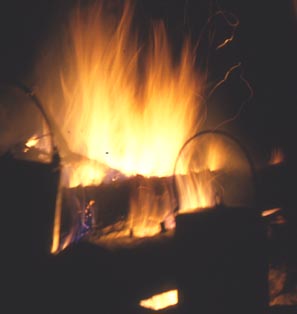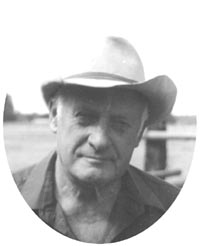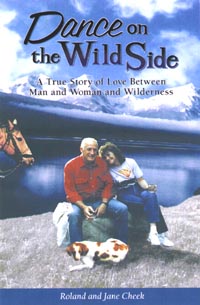The book Learning To Talk Bear is the best book I have ever read and prepared me for my first grizzly sighting / email from Susan Bearer
You can read the weblog Jennifer refers to by hitting the yellow archives button on the left, then going to February 6, 2007 - Poker or Camping: He'd Do To Draw To
Chocolate Legs is a superb book capturing the essence of a single wild animal. It will reside on my bookshelf alongside the best of Will James or Farley Mowat / Duncan LaSade letter
a weblog sharing info on outdoor skills and campfire musing by a guy who spends a bunch of time in pursuit of both
CULTURE
WHERE -
TALES ARE TOLD OF
Welcome to Roland Cheek's Weblog
Roland is a gifted writer with a knack for clarifying reality. Looking forward to more of his wisdom
- Carl Hanner e-mail
It is said General U.S. Grant once expressed contempt for a certain officer. Another officer protested that the man in question had been through 10 campaigns.
"General," said Grant, "so has that mule yonder, but he's still a jackass."
Having lived my three-score ten, I fear Grant is right -- experience is not a trustworthy measure of intelligence. On the other hand, having spent a modicum of time in the company of mules, I'd reckon them as some smarter than most generals.
To acess Roland's weblog and column archives
Tip o' the Day
Ever out in the big lonesome and discovered your watch quit God knows how many hours ago and you need to know how much time left until sundown? Line one hand between sun and horizon (arm outstretched, fingers together at right angle to the arm); each finger is approximately 15 minutes.
How about direction when you're without a compass and it's a dank, overcast day? Forget that old wives' tale about moss growing heavier on the north side of trees. Moss grows slowly in the high country at our latitude and you don't have time to wait for it to grow. Try this instead:
Spread a white cloth (handkerchief, T-shirt, longhandle underwear (if it's still white) flat upon the ground. Hold a slender stick vertically, moving it around the perimeter of the cloth. A suggestion of a shadow can be determined when the stick is between sun and cloth, even when the sun cannot be otherwise located. Now point the hour-hand of your watch at the sun. Halway betweeen the hour hand and 12 0'clock is due south. (Note: use standard time. Note: those with digital watches will have to fake it.)
What happens when you've discovered south and how much time until sundown, but still don't know which direction to camp, nor how long it'll take to get there?
Survival books say to "Stop early enough to gather firewood for the night," and it's good advice. Most of 'em don't tell you how much wood to gather, however, so I'll tell you to lay in more than you'll need . . . then double the supply. Having slept out many nights using chaps for pajamas, backed against a rock wall or boulder to reflect heat, drowsily fighting sparks from my new wool coat, I qualify as an expert. And I say night is always darkest just before dawn. It's also coldest. Ironically, dawn is also when you'll run out of fire--if you've shorted your wood supply the night before.
Of course if a man straddles a good horse there's no logical reason to gather a big supply of firewood and spend the night in the fearsome lonesome unless he wishes to do so. Give a veteran horse his head and you'll eat supper in camp. Confuse him and you might wind up as hungry as an Ethopian famine survivor.
I once followed my pony down a perilous trail in an inky night. I did so by tying the halter rope to his bridle reins, then walking behind with one hand loose-holding the rope and the other holding his tail. I figured to let both go if he disappeared into the chasm below. He never even stumbled.
In fact, if anything, he seemed put out that I never crawled into the saddle and let him hurry home.
I am sitting here with tears pouring down my cheeks in great appreciation for what you have written about my father in law. I am the mother of "his" triplet grandchildren . . . It is hard for me to explain what a BIG loss it has been because it is hard to explain to people what a great person he truly was / email from Jennifer West
* * *
TWO GIANT MARCH BLOW-OUTS
Two remarkable yearly events arrive following mid-March: Saint Patrick's Day and the ides of March (or the first day of spring). Perhaps we should get right into Saint Paddy first:
The patron Saint of Ireland's background began with a lurch when he was captured from his British homeland at age sixteen and sold into slavery in Ireland. The sudden shift of fortune was apparently what the young Patrick needed to take his religion seriously. And upon his escape six years later, the young man determined to convert his former Irish masters to Christianity. he was 43 years old when next the man set foot on the shamrock shores.
Though not especially noted as a learned scholar, Saint Paddy must have been eloquent and persuasive, arriving to a pagan isles shoeless and friendless, leaving its residents converted Christians just 29 years later.
The question: Where's the leap from this noble man of God to shamrocks and leprechauns, bagpipes and accordions? Or might the Saint's success be that he best appealed to the jovial Irish by drinking green beer while singing and dancing amid Downtown Dublin's cobbled streets?
That spring officially arrives just three days after Saint Paddy's Day is especially fitting; it takes most of my Irish friends that long to get over their green-beer dyspepsia.
There are two times each year when the central star of our solar system is exactly over the earth's equator. In the fall, it's called the autumnal equinox, occuring on or about September 23. The vernal, or spring, equinox occurs March 20. What the equinoxes really mean is that night and day are of equal duration, no matter what tricks we try to play by setting our clocks backward or forward. After the vernal equinox, days grow longer, remaining so until the autumnal equinox in September. Increasing daylight triggers plant growth. Petunias will bloom. Lawns will soon need mowing. Robins sing, honkers wing north. Mountain snowpacks melt, rivers rise, bears emerge from their dens. Soon, elk calves will gambol. It's the season of renewal. And all those natural wonders occur like clockwork every 365 days.
Astronomers tell us the earth's spin causes night and day. That spin--once every 24 hours--brings us exposure to the sun and suitable darkness to aid sleeping at night. But the spin doesn't slow while we're basking in sunbeams, or speed up after old sol passes over the yardarm. Nope, the additional daylight comes, not because our sun moves north or south during season, but because our world tilts on its axis as it orbits the sun, something like a big, wobbly child's top, tilting first one way, then another in a predictable and consistent way.
So we're riding a big top that is spinning around once every 24 hours while also orbiting the sun once every 365 days. In addition, the fool thing is wobbling on its axis like it's about to run down.
What does all that mean?
Well, when you read it like that it sounds as though the top is about to run out of spin and will topple on its side most any minute. When you read it like that it sounds like we'd all ought to tell someone we love them, then try to get our lives whipped into order. Forget El Nino or La Nina--they make no difference.
But the top has been spinning just the same way for thousands--probably for millions--maybe for billions of years while wobbling the exact same way on its axis. And after all that, it hasn't run out of oomph.
So what's the real question?
Who spins the top?
Roland Cheek wrote a syndicated outdoors column (Wild Trails and Tall Tales) for 21 years. The column was carried in 17 daily and weekly newspapers in two states. In addition, he scripted and broadcast a daily radio show (Trails to Outdoor Adventure) that aired on 75 stations from the Atlantic seaboard to the Pacific Ocean. He's also written upwards of 200 magazine articles and 12 fiction and nonfiction books. For more on Roland, visit:
www.rolandcheek.com
Recent Weblogs
Tuesday, March 17, 2009
for more info about these and other Roland Cheek books
There's also tales of the antics of Robert West and his brothers in Roland's book on elk, The Phantom Ghost of Harriet Lou. You'll find more specific info about Roland's books, columns, and archives by clicking the buttons highlighted right and left. One can read a synopsis of each book, read reviews, and even access the first chapter of each of his titles.
for detailed info about each of Roland's books
Read Reviews
Read their first chapters
For interested educators, this weblog is especially applicable for use in environmental / nature classes, as well as for journalism students.
Roland, of course, visits schools. For more information on his program alternatives, go to:
I have just finished reading The Phantom Ghost of Harriet Lou and it touched my soul. You've illustrated everything that I embrace about hunting and elk hunting to be more specific / Mitch Ratigan email
I just finished your book Dance On the Wild Side. I didn't want it to end. You said you didn't finish high school. Where in the world did you learn to write like that? / Barb Richards email
My Best Work is Done at the Office is pure Roland Cheek, that is, a blend of wit, wisdom, and adventure in the Northern Rocky Mountains / testimonial on way to five star (*****) amazon.com rating
Next Week:
I ONLY NEEDED A QUILL PEN AND AN ABACUS
www.campfireculture.com
to send this weblog to a friend
to tell Roland what you think of his Campfire Culture weblog
source links for additional info
to visit Roland's newspaper columns and weblog archives







